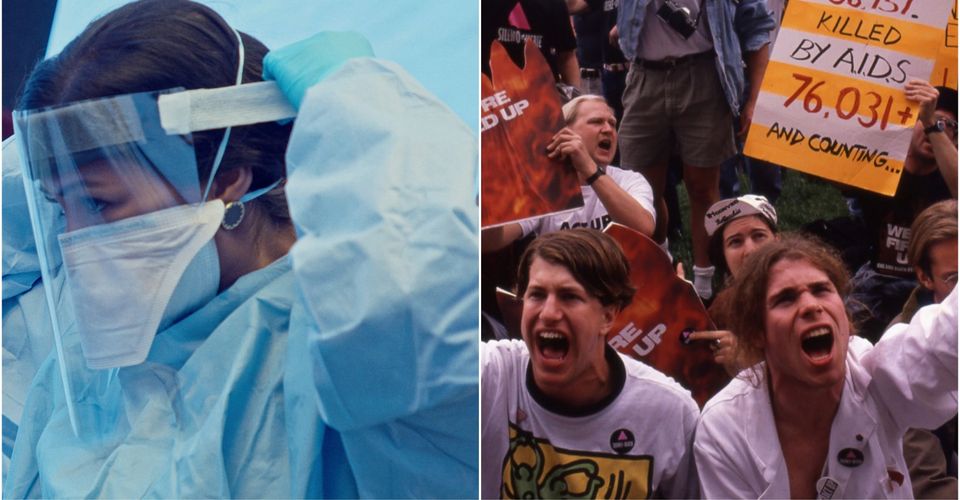Pandemic: 8 Vital Documentaries About How Disease Spreads

Viral pandemics have been on everyone’s mind lately as news of the recent coronavirus outbreak spreads with as much voracity as the deadly RNA strain itself. There have been over 80,000 confirmed cases of this latest epidemic so far, which originated in China’s Wuhan Province. This is not the first virus whose transmission soared to uncontrollable rates, and it’s definitely not the first to take thousands of lives.
The documentaries on this list are educational access points for anyone who wants to learn about the science behind the spreading of contagious diseases. These films and miniseries also delve into the logistics of responding to these medical crises, as well as explaining how more of them can be avoided in the future by examining past pandemics.
8 How To Survive A Plague (2012)

This harrowing documentary about the AIDS epidemic in America during the ’80s and early ’90s focuses on the activist organizations that worked tirelessly to bring the crisis to the attention of the government. HIV transmission soared within gay male communities in the early ’80s, and due to rampant homophobia, thousands of people died before organizations like the FDA and the CDC took the epidemic seriously.
Groups like ACT UP and TAG held numerous demonstrations and protests in order to advocate for more access to affordable drugs and viable treatments for HIV and AIDS. For most of the ’80s, the only drug available to Americans, AZT, cost $10,000 a year and had terrible side effects, including blindness. While this documentary focuses more on the politics behind disease treatment, it’s an important film to watch in order to understand why viruses tend to proliferate in marginalized communities.
7 Pandemic (2020)

This new Netflix docuseries in six parts focuses on the medical workers at the frontlines of disease control and cessation. From the common flu to Ebola, each segment shows how doctors are attempting to find cures for many deadly diseases while often working with few resources.
Pandemics are always around the corner, and diseases adapt to migration, displacement, and climate change. In addition to the flu and Ebola, Pandemic also delves into vaccinations and how some viruses spread from animals to people, which is called zoonosis. It also highlights how these life-ending diseases have a propensity to spread in poorer, more populated regions, where residents have little routine healthcare access and limited knowledge about prevention.
6 Fire In The Blood (2013)

Even though an American living with HIV or AIDS today is guaranteed to live a full life with access to medication, these viruses still run rampant throughout parts of Africa and the global south. In fact, over 20 million of the nearly 38 million people living with HIV in the present reside in the eastern and southern regions of Africa. Since it was discovered in the early ’80s, AIDS has been responsible for 32 million deads worldwide, and it is still considered a global pandemic.
Fire in the Blood blames for-profit pharmaceutical companies for refusing to supply many African countries with affordable HIV and AIDS drugs, It also explains how many Western countries have blood on their hands for supporting the multi-billion dollar industry. Narrated by William Hurt, the documentary features the activists, medical professionals, and lawyers who fight for equitable access to medications by pushing for an end to the intentional blockades, both in court and on the streets.
5 Spillover – Zika, Ebola & Beyond (2018)

Spillover refers to diseases that spill over from animals to humans, also known as zoonosis, and this PBS documentary tries to figure out why so many diseases have spilled over in the past half-century. In the 2010s alone, the world was rocked by the Zika virus in Brazil and Ebola in West Africa, both of which have animal origins. In addition to Zika and Ebola, HIV/AIDS, MERS, and SARS are all zoonotic diseases.
In this compelling documentary, which highlights struggles to contain zoonotic disease transmissions that are often excluded from news headlines, film crews go deep into the worlds of traveling medics and disease experts who are both studying diseases historically and fighting them in the present. The narrative is moved along by firsthand accounts from people affected by spillover, yet it also contains plenty of insight into the science behind these diseases.
4 Ebola Fighter: Hero With A Thousand Faces (2016)

This documentary explores the Ebola epidemic that devastated West Africa between 2013 and 2016, which resulted in nearly 30,000 positive cases of the virus and over 11,000 deaths. It originated in Guinea and quickly spread to Liberia and Sierra Leone, and it’s considered the worst Ebola outbreak in history.
The film’s crew traveled to Sierra Leone to showcase the medical workers and volunteers who daily exposed themselves to the brutal virus in hopes of containing it. If someone contracts Ebola, cold symptoms soon transform into gastrointestinal problems. From there, the liver and kidneys fail and victims usually die as a result of internal bleeding. Ebola is highly contagious, and it spreads via bodily fluids from person to person.
3 Mosquito (2017)

This Discovery Channel documentary discusses the role mosquitos play in the spread of disease. While mosquitos themselves are not disease-ridden, the viruses and pathogens they carry from biting people and animals are what makes them so potentially dangerous. Mosquitos are known as vectors, which move diseases between sources. Thanks to climate change, mosquitos are present in more places for longer parts of the year, meaning viruses that were once isolated geographically are now spreading more rapidly.
Mosquito explains the role these bugs played in the West Nile, Zika, and dengue viruses of recent years, as well as the role they’ve played in spreading malaria. While connections between the various moving parts working to escalate the rates of infection are still being figured out, the documentary attempts to connect all the dots based on the research and science available.
2 Influenza 1918 (1998)

A PBS American Experience feature, Influenza 1918 tells the story of a long-forgotten, yet extremely deadly, pandemic, one of the worst in the world’s history. As WWI wrapped up, a deadly form of the H1N1 virus moved swiftly from country to country, killing 50 million people, including 600,000 in America. In total, 500 million people were infected, from those in populous cities to the most remote, rural corners of the world.
There are many theories as to why what came to be known as the Spanish flu spread so rapidly and killed so many. While some scientists believe it had a unique ability to attack healthy immune systems, others point to environmental factors like poor hygiene, overcrowded hospitals, and malnourishment.
1 We Were Here (2011)

While How To Survive A Plague focuses on the HIV/AIDS epidemic in New York, We Were Here focuses on the same medical crisis in San Francisco, long considered a mecca for LGTBQ+ folks. The documentary profiles 5 people who had prominent roles in fighting the disease, from activists to nurses to counselors to dancers.
This personal and emotional documentary pays tribute to the lives behind the statistics, showing the toll these infections and viruses have on loved ones, family members, and overworked medical staff. The documentary also shows how communities are capable of coming together to help those in need.
About The Author

















